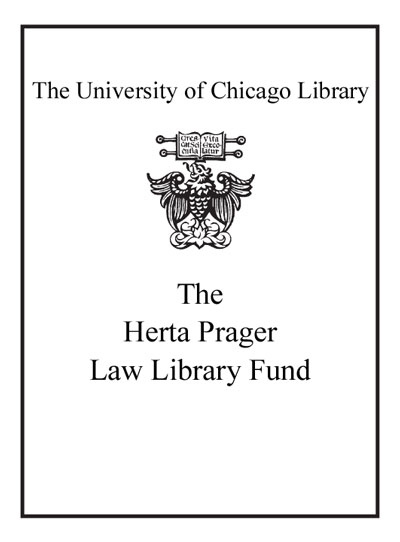Reasoning rights : comparative judicial engagement /
Saved in:
| Imprint: | Oxford : Hart Publishing, ©2014. |
|---|---|
| Description: | xl, 391 pages ; 25 cm |
| Language: | English |
| Subject: | |
| Format: | Print Book |
| URL for this record: | http://pi.lib.uchicago.edu/1001/cat/bib/10128759 |
Table of Contents:
- Preface
- Author Biographies
- Part 1. Introduction
- 1. The Pluralism of Human Rights Adjudication
- I. Method and Scope
- II. The Adjudicatory Pluralism of Human Rights
- III. Conclusion
- Part 2. Proportionality
- 2. Constructing the Proportionality Test: An Emerging Global Conversation
- 3. Necessity and Proportionality: Towards a Balanced Approach
- I. Introduction
- II. Two Problems with Strict Necessity
- III. Toward a Moderate Interpretation of Necessity
- IV. Conclusion
- 4. Proportionality Without Balancing: Why Judicial Ad hoc Balancing is Unnecessary and Potentially Detrimental to the Realisation of Individual and Collective Self-determination
- I. Introduction
- II. Why Ad hoc Balancing is Potentially Detrimental to the Realisation of Collective and Individual Self-determination
- III. Why Ad hoc Balancing is Unnecessary: A Comparative Perspective
- IV. Coming Clean: Proportionality Without Ad hoc Balancing
- 5. Proportionality in United States Constitutional Law
- I. Introduction
- II. The European Proportionality Inquiry
- III. Necessity and Balancing
- IV. Tiered Scrutiny and Variable Intensity of Review
- V. The Historical Origins of Proportionality and Balancing in the US and Germany
- VI. Conclusion
- Part 3. National Security and Human Rights
- 6. 'To the Serious Detriment of the Public': Secret Evidence and Closed Material Procedures
- I. Introduction
- II. The Importance of Open Justice
- III. Balancing Open Justice with Other Public Interests
- IV. Exploring Ways to Balance Open Justice and Broader Public Interests
- V. Conclusion
- 7. National Security Law and the Creep of Secrecy: A Transatlantic Tale
- I. Introduction
- II. The Norwich Pharmacal Jurisdiction in English Law
- III. The Binyam Mohamed Case
- IV. Reactions to Binyam Mohamed
- V. National Security Litigation in the US: The Breadth of Secrecy
- VI. A Clash of Legal Cultures
- VII. The Wider Impact of the Norwich Pharmacal Issue
- VIII. Conclusion
- 8. Navigating the Shoals of Secrecy: A Comparative Analysis of the Use of Secret Evidence and 'Cleared Counsel' in the United States, the United Kingdom, and Canada
- I. Introduction
- II. The Processes Explained
- III. Applicable Principles
- IV. Identifying 'Best Practices'
- V. Common Problems
- VI. Conclusion
- 9. The Secret Keepers; Judges, Security Detentions, and Secret Evidence
- I. Introduction
- II. Security Detentions, Secrecy and Judicial Review
- III. Security Detentions in Israel
- IV. Reasoning Rights: Balancing Security and Liberty in the Shadows of Secrecy
- V. Realising Rights: The Outcomes of Judicial Review Relating to the Named Individuals
- VI. Between Reasoning Rights and Realising Rights: Jaber Mamduch Aberah v IDF Commander in the West Bank
- VII. The Secret Keepers: Behind the Closed Doors of the Judicial Management Model
- VIII. Judicial Management vs Special Advocates
- IX. Conclusion
- Part 4. Religion and Human Rights
- 10. The Intersection of Religious Autonomy and Religious Symbols: Setting the Stage
- I. Introduction
- II. Introducing the Cases
- III. Framing the Issues
- IV. The Models Applied and Tested
- V. The Contributions
- VI. Conclusion
- 11. Principles and Compromises: Religious Freedom in a Time of Transition
- I. Introduction
- II. Four Approaches to Religious Autonomy at Work Cases
- III. Conclusion
- 12. State Interference in the Internal Affairs of Religious Institutions
- I. Introduction: The Focus of Sphere Sovereignty Defined
- II. Internal Powers of Religious Institutions
- III. Concluding Observations
- 13. The Protection of Religious Freedom in Australia: A Comparative Assessment of Autonomy and Symbols
- I. Introduction
- II. The Protection of Religious Freedom in Australia
- III. Comparative Assessment
- IV. Conclusion
- Part 5. Socio-Economic Rights
- 14. The Emergence and Enforcement of Socio-Economic Rights
- I. Introduction
- II. The Emergence of Socio-Economic Rights
- III. South Africa and the Culture of Justification
- IV. India, the United States, and the Promise of Judicial Activism
- V. The Future of Socio-Economic Rights Jurisprudence
- VI. Conclusion
- 15. The Problematic of Social Rights - Uniformity and Diversity in the Development of Social Rights Review
- I. Introduction
- II. The Orthodox Distinction between 'Permissible' Civil and Political Rights Review and 'Impermissible' Social Rights Review
- III. The Unstable Distinction between Civil/Political and Social Rights Review
- IV. The Questionable Legitimacy of the Orthodox Position
- V. The 'Social Rights Problematic'
- VI. The Diverse Forms of Social Rights Review
- VII. Questioning Uniformity: The Case for Diversity in Social Rights Review
- VIII. Conclusion
- 16. A South African Perspective on the Judicial Development of Socio-Economic Rights
- I. Introduction
- II. Objections to Socio-Economic Rights
- III. Setting the Standard for Judicial Review
- IV. Critical Analysis of the Constitutional Court's Approach to Socio-Economic Rights
- V. Crafting Appropriate Remedies in Socio-Economic Rights Cases
- VI. The South African Approach in Comparative Perspective
- VII. Lessons for Other Jurisdictions
- 17. Judicial Activism and the Indian Supreme Court: Lessons for Economic and Social Rights Adjudication
- I. Introduction
- II. Directive Principles of State Policy, Land Reform and the Judiciary
- III. Public Interest Litigation: Making Directive Principles of State Policy Justiciable
- IV. Later Cases: Judicial Activism Curtailed?
- V. Lessons from the Indian Experience of Economic and Social Rights Adjudication
- VI. Conclusion
- 18. American Exceptionalism over Social Rights
- I. Introduction
- II. The First Irony: Exceptional Judicial Enforcement of Certain Social Welfare Rights
- III. The Second Irony: Mixed Results
- IV. Potential Causes
- V. Conclusion and Lessons for Other Countries
- Index

